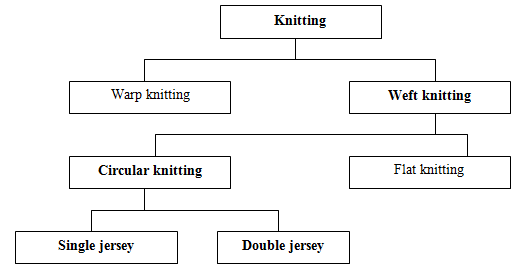What is Knitting
 |
| What is Knitting | Classification of knitting |
The fabrics produced by knitting are used for various applications like clothing, home textiles, medical textiles, geotextiles, and sports textiles. Knitted fabrics are known for their elasticity and seamless finish, which makes them suitable for producing garments like socks, hats, and gloves using circular knitting machines.
নিটিং ত্রুটি এবং প্রতিকার | Common knitting faults and Remedies
Warp knitting, on the other hand, is used to create fabrics in a flat shape and is often used to produce items such as lingerie, swimwear, and sportswear. Overall, knitting is a crucial process in textile engineering, and it plays an essential role in the production of a broad range of fabrics.
Classification of knitting:
 |
| What is Knitting | Classification of knitting |
Warp knitting :
A method of making a fabric by
normal knitting means is which the loop made from each warp thread is formed
substantially along the length of the fabric. Characterized by the fact that
each warp thread is feed more or less in the line with the direction in which
the fabric is produced.
 |
| Warp Knitting |
Weft knitting:
A method of making a fabric by
normal knitting means is which the loop made from each weft thread formed substantially
along the length of the fabric. Characterized by the fact that each warp thread
is feed more or less in the line with the direction in which the fabric is
produced.
Single jersey:
A fabric in which all the loops of
the Wales are intermeshed in one direction is called single jersey. Only
cylinder is used to make single jersey fabric. End Products of Single Jersey
Circular Knitting Machine:
1. Single Jersey Plain
2. Single Lacoste
3. Double Lacoste
4. Single pique
5. Double pique
6. Terry
7. Heavy Jersey
Double jersey:
A fabric in which all the loops of
the alternate wale/Wales are inter-meshed in one direction and all the loops of
the other wales knitted t the same course are inter-meshed in the other
direction is called the double jersey. Dial and cylinder are used to make this
type of fabric.
Related Tag:
What is knitting in short answer?
What is this knitting?
What are the 2 types of knitting?
Why is it called knitting? What is the process of knitting?
What is the most common type of knitting?
knitting definition in textile
types of knitting
what is knitting short answer
two types of knitting
how to pronounce knitting
what is knitting process
what is knitting and crocheting
history of knitting
আরও পরুন:

